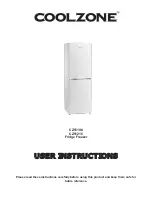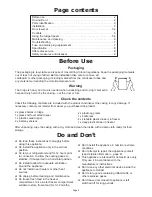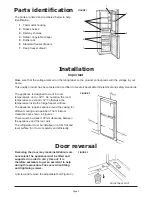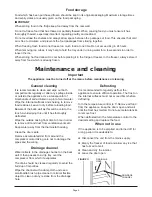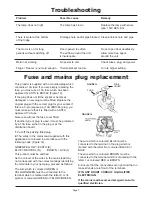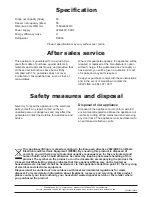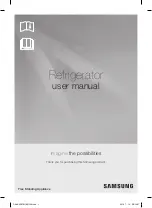
Page 6
General cleaning
It is recommended to clean and wipe out both
compartments regularly or after any spillage inside
or outside the appliance. Use a teaspoonful of
bicarbonate of soda diluted in a pint of warm water.
Wipe the internal surfaces and shelving to remove
food residues. Leave to dry before reloading food.
Beware of the back wall as this will be cold to the
touch. Avoid wiping this until it has thoroughly
defrosted.
Wipe the outside casing from time to time in order
to remove dirt and dust from ventilation vents etc.
Keep water away from the thermostat housing.
Clean the door seals.
Remove accumulated dirt from around the
compressor motor taking care not to damage the
pipes and the wiring.
Drainage channel
Water collects in the drainage channel on the back
wall. It then passes to a drip tray over the
compressor from which it evaporates.
The drain should be cleaned regularly to avoid the
build up of impurities.
Wipe the channel with a damp cloth and use a
small bottle brush, pipe cleaner or similar flexible
object to clean out any residue from the drainage
hole.
FIGURE 11
DRAINAGE
HOLE
DRAINAGE
CHANNEL
Maintenance and cleaning
Important
The appliance must be turned off at the mains before maintenance or cleaning.
Defrosting
It is recommended to regularly defrost the
appliance to ensure efficient operation. The frost on
the internal surfaces must not exceed 6mm before
defrosting.
Turn the temperature control to ‘0’.Remove all food
from the appliance, keep the doors open and wait
until the frost has melted. Do not use metal utensils
to remove frost.
When defrosted turn the temperature control to the
desired setting and replace the food.
When not in use
If the appliance is to be emptied and turned off for
a long period it is advisable to:
Disconnect the unit from the mains supply.
Empty the freezer of food and allow any ice that
has formed to melt.
Clean and dry the interior.
Leave the door open.
Food storage
Food which has been purchased frozen should be kept in its original packaging. Maximum storage times
and expiry dates are usually given on the food packaging.
IMPORTANT
When storing food in the fridge keep food away from the rear wall.
Do not re-freeze food that has thawed or partially thawed. When cooking food you must ensure it has
thoroughly thawed, especially important regarding poultry and seafood.
Do not overload the shelves and always allow space between the packages of food. This ensures that cold
air is free to circulate, and prevents the food packages from sticking together.
When freezing fresh food do not freeze too much food at one time. Do not exceed 4kg in 24 hours.
When removing ice cubes, it may help to hold the tray under running water for a few seconds in order to
loosen the ice.
When storing hot food allow it to cool before placing it in the fridge or freezer. In the freezer, always store it
away from food which is already frozen.

